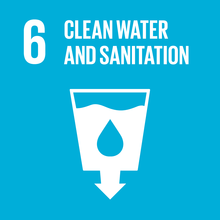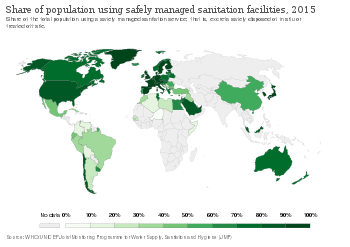Sustainable Development Goal 6
Sustainable Development Goal 6 (SDG6 or SDG 6) is one of 17 Sustainable Development Goals established by the United Nations General Assembly in 2015. It calls for clean water and sanitation for all people. The official wording is: "Ensure availability and sustainable management of water and sanitation for all."[1] The goal has eight targets to be achieved by at least 2030. Progress toward the targets will be measured by using eleven "indicators."

SDG 6 is closely linked with other Sustainable Development Goals (SDGs).
Background
The UN has determined that access to clean water and sanitation facilities is a basic human right.[2] Over 2 billion people in the world lack access to water that is free of health risks.[3] By 2017, eighty countries provided access to clean water for more than 99% of their population.[4] From 2000 to 2017, the global population that lacked access to clean water decreased from nearly 20% to roughly 10%.[3]
Ending open defecation will require provision of toilets and sanitation for 2.6 billion people as well as behavior change of the population.[5] This will require cooperation between governments, civil society and the private sector.[6]
Targets and indicators



SDG 6 has eight targets. Six of them are to be achieved by the year 2030, one by the year 2020 and one has no target year.[8] Each of the targets also has one or two indicators which will be used to measure progress. In total there are 11 indicators for SDG6.[9]
SDG 6 includes eight global targets that are aspirational.[10] Each government must decide how to incorporate them into national planning processes, policies and strategies based on national realities, capacities, levels of development and priorities.[10] The eight goals cover the entire water cycle including: "provision of drinking water (target 6.1) and sanitation and hygiene services (6.2), treatment and reuse of wastewater and ambient water quality (6.3), water-use efficiency and scarcity (6.4), IWRM including through transboundary cooperation (6.5), protecting and restoring water-related ecosystems (6.6), international cooperation and capacity-building (6.a) and participation in water and sanitation management (6.b).[10]
The first three targets relate to drinking water supply and sanitation:[8]
- By 2030, achieve universal and equitable access to safe and affordable drinking water for all
- By 2030, achieve access to adequate and equitable sanitation and hygiene for all and end open defecation, paying special attention to the needs of women and girls and those in vulnerable situations.
- By 2030, improve water quality by reducing pollution, eliminating dumping and minimizing release of hazardous chemicals and materials, halving the proportion of untreated wastewater and substantially increasing recycling and safe reuse globally
Safe drinking water and hygienic toilets protect people from disease and enable societies to be more productive economically. Attending school and work without disruption supports education and employment, both of which are the foundation of alleviating poverty. Therefore, toilets at school and at the work place are included in the second target ("achieve access to adequate and equitable sanitation and hygiene for all"). Equitable sanitation and hygiene solutions address the needs of women and girls and those in vulnerable situations, such as the elderly or people with disabilities.
Water sources are better preserved if open defecation is ended and sustainable sanitation systems are implemented. Preserving natural sources of water is very important so as to achieve universal access to safe and affordable drinking water. Therefore, one target aims to reduce water pollution by eliminating dumping and minimizing the release of hazardous chemicals and untreated wastewater. The potential for recycling and safe reuse of wastewater is also mentioned.[8]
Indicators
Indicators include (the numbering refers to the target number):[11][7]
- 6.1.1 Proportion of population using safely managed drinking water services
- 6.2.1 Proportion of population using (a) safely managed sanitation services and (b) a hand-washing facility with soap and water
- 6.3.1 Proportion of domestic and industrial wastewater flows safely treated
- 6.3.2 Proportion of bodies of water with good ambient water quality
- 6.4.1 Change in water-use efficiency over time
- 6.4.2 Level of water stress: freshwater withdrawal as a proportion of available freshwater resources
- 6.5.1 Degree of integrated water resources management
- 6.5.2 Proportion of transboundary basin area with an operational arrangement for water cooperation
- 6.6.1 Change in the extent of water-related ecosystems over time
- 6.a.1 Amount of water- and sanitation-related official development assistance that is part of a government-coordinated spending plan
- 6.b.1 Proportion of local administrative units with established and operational policies and procedures for participation of local communities in water and sanitation management
The main indicator for the sanitation target (target 6.2) is the "Proportion of population using safely managed sanitation services, including a hand-washing facility with soap and water".[9] The current statistic in the 2017 baseline estimate by the Joint Monitoring Programme for Water Supply and Sanitation (JMP) is that 4.5 billion people currently do not have safely managed sanitation.[5] The JMP is a joint program of UNICEF and WHO and compiles data to monitor SDG6 progress.
The definition of safely managed sanitation service is: "Use of improved facilities that are not shared with other households and where excreta are safely disposed of in situ or transported and treated offsite."[5]:6 Improved sanitation facilities are those designed to hygienically separate excreta from human contact.[5]:6
.jpg)
As of 2017, two-thirds of countries lacked baseline estimates for SDG indicators on hand washing, safely managed drinking water, and sanitation services.[12]
Progress
Status in 2019
Between 2000 to 2015, the percentage of global population using safely managed drinking water serviced has increased from 61 to 71 per cent. But this remained unchanged in 2017. In total, 785 million people around the world still lacked basic drinking water service.[13]
Globally, the proportion of population using safely managed sanitation services increased from 28 per cent in 2000 to 43 per cent in 2015, with another 2 per cent increase in 2017. Latin America and the Caribbean, sub-Saharan Africa, and East and Southeast Asia recorded the largest increase. In total, there are still 701 million people around the world who still had to practice open defecation in 2017.[13]
In terms of basic hand-washing facilities with soup and water at home, about 60 per cent of people worldwide have this facility. However, within the least developed countries, only 38 per cent had such facilities, translating to about 3 billion people still without basic handwashing facilities at home.[13]
Links with other SDGs
The SDGs are all interlinked. WASH experts have stated that without progress on Goal 6, the other goals and targets cannot be achieved.[14][15] In other words, accomplishing the other SDGs will require assuring clean water and sanitation for all as stated in SDG 6.[16]
For example, improving sanitation also helps make cities more sustainable (Goal 11). Sanitation improvements can lead to more jobs (Goal 8) which would also lead to economic growth (Goal 8).[17] SDG 6 progress improves health (Goal 3) and social justice (Goal 16).[18] Recovering the resources embedded in excreta and wastewater (like nutrients, water and energy) contributes to achieving Goal 12 (sustainable consumption and production) and Goal 2 (end hunger). Ensuring adequate sanitation and wastewater management along the entire value chain in cities contributes to Goal 11 (sustainable cities and communities), Goal 1 (no poverty) and Goal 8 (decent work and economic growth).[17]
Sanitation systems with a resource recovery and reuse focus are getting increased attention.[19] They can contribute to achieving at least fourteen of the SDGs, especially in an urban context.[17]
Organizations
The Sustainable Sanitation Alliance (SuSanA) has made it its mission to achieve SDG 6.[20][21] SuSanA's position is that the SDGs are highly interdependent. Therefore, the provision of clean water and sanitation for all is a precursor to achieving many of the other SDGs.[22] Global organizations such as Oxfam, UNICEF, WaterAid and many small NGOs as well as universities, research centres, private enterprises, government-owned entities etc. are all part of SuSanA and are dedicated to achieving SDG 6.[23]
See also
- List of SDG targets and indicators
- Water, sanitation, hygiene (WASH)
References
- "Goal 6: Clean water and sanitation". UNDP. Retrieved 28 September 2015.
- "World Water Development Report 2019 - Leaving No One Behind". UNESCO. 2019-02-11. Retrieved 2019-08-01.
- WHO/UNICEF Joint Water Supply and Sanitation Monitoring Programme. World Health Organization, issuing body. UNICEF, issuing body. (2019). Progress on household drinking water, sanitation and hygiene 2000-2017: Special focus on inequalities. p. 26. ISBN 9789241507240. OCLC 890621984.CS1 maint: multiple names: authors list (link)
- World Health Organization. UNICEF. Progress on sanitation and drinking-water : 2014 update. ISBN 9789240692817. OCLC 889699199.
- WHO and UNICEF (2017) Progress on Drinking Water, Sanitation and Hygiene: 2017 Update and SDG Baselines. Geneva: World Health Organization (WHO) and the United Nations Children’s Fund (UNICEF), 2017
- Kellogg, Diane M. (2017). "The Global Sanitation Crisis: A Role for Business". Beyond the bottom line: integrating sustainability into business and management practice. Gudić, Milenko,, Tan, Tay Keong,, Flynn, Patricia M. Saltaire, UK: Greenleaf Publishing. ISBN 9781783533275. OCLC 982187046.
- Ritchie, Roser, Mispy, Ortiz-Ospina (2018) "Measuring progress towards the Sustainable Development Goals." (SDG 6) SDG-Tracker.org, website
- "Goal 6 Targets". United Nations Development Programme. Retrieved 16 November 2017.
- "SDGs". Sustainable Development Knowledge Platform. Retrieved 17 November 2017.
- Sustainable development goal. 6, Synthesis report 2018 on water and sanitation. New York, New York: UN-Water, United Nations. August 2018. ISBN 9789211013702. OCLC 1107804829.
- "SDG Indicators - Global indicator framework for the Sustainable Development Goals and targets of the 2030 Agenda for Sustainable Development". United Nations Statistics Division (UNSD). Retrieved 6 August 2020.
- "Progress for Every Child in the SDG Era" (PDF). UNICEF. Retrieved 2 April 2018.
- "Special edition: progress towards the Sustainable Development Goals. Report of the Secretary-General". undocs.org. Retrieved 2019-11-21.
- Rao Gupta, Geeta (October 2015). "Opinion: "Sanitation, Water & Hygiene For All" Cannot Wait for 2030". Inter Press. Retrieved 23 October 2015.
- Batty, Margaret (25 September 2015). "Beyond the SDGs: How to deliver water and sanitation to everyone, everywhere". Retrieved 23 October 2015.
- SuSanA (2017). "Sustainable sanitation and the SDGs: interlinkages and opportunities". Sustainable Sanitation Alliance, Eschborn, Germany.
- Andersson, Kim; Dickin, Sarah; Rosemarin, Arno (2016-12-08). "Towards "Sustainable" Sanitation: Challenges and Opportunities in Urban Areas". Sustainability. 8 (12): 1289. doi:10.3390/su8121289.
- "Press release – UN General Assembly's Open Working Group proposes sustainable development goals" (PDF). Sustainabledevelopment.un.org. 19 July 2014. Retrieved 2016-10-18.
- Paranipe, Nitin (14 November 2017). "The rise of the sanitation economy: how business can help solve a global crisis". Thomson Reuters Foundation News. Retrieved 14 November 2017.
- "Vision". Sustainable Sanitation Alliance. Retrieved 16 November 2017.
- "Contribution of sustainable sanitation to the Agenda 2030 for sustainable development - SuSanA Vision Document 2017". SuSanA, Eschborn, Germany. 2017. Archived from the original on 2017-11-16.
- "Sustainable sanitation and the SDGs: interlinkages and opportunities". Sustainable Sanitation Alliance Knowledge Hub. 16 November 2017. Archived from the original on 2017-11-17. Retrieved 16 November 2017.
- "Contribution of sustainable sanitation to the Agenda 2030 for sustainable development - SuSanA Vision Document 2017". SuSanA, Eschborn, Germany. 2017.